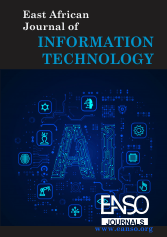Integration of Information Communication Technology in Education in Ugandan Secondary Schools: Prospects for Improved Academic Performance
Résumé
Integrating digital tools has significantly transformed education systems, especially after the COVID-19 pandemic, leading to a paradigm shift in teaching and learning. This study examined how Information and Communication Technology (ICT) influences the academic performance of secondary school students in Uganda. A qualitative exploratory design was adopted, involving purposive interviews with 80 students. The findings reveal that despite the challenges of high digital costs, students have widely embraced ICT in learning. Online platforms enhance student engagement and help clarify abstract concepts through simulations and demonstrations. Students can share learning content with peers and teachers on virtual platforms. Moreover, ICT tools supplement classroom instruction, bridge knowledge gaps, and empower learners to develop independent study habits and personalised learning strategies. The study concludes that ICT is a transformative force in education. It recommends developing and implementing a comprehensive national policy to support Uganda’s Digital Agenda Strategy (2021–2025). It further advocates for expanded digital infrastructure in all schools and subsidies on internet access and digital devices to ensure equitable access
##plugins.generic.usageStats.downloads##
Références
Abuga, T. M. (2020). Utilization of Partograph in Management of Women in Labor among Nurses/Midwives Working in Machakos County, Kenya. Kenyatta University.
Balikuddembe, M. S., Tumwesigye, N. M., Wakholi, P. K., & Tylleskär, T. (2017). Computerized Childbirth Monitoring Tools for Health Care Providers Managing Labor: A Scoping Review. JMIR Medical Informatics, 5(2), e14. https://doi.org/10.2196/medinform.6959
Bazirete, O. (2014). Utilization of Partogram among Nurses and Midwives in Rwamagana Health Facilities in the Eastern Province of Rwanda.
Bazirete, O., Mbombo, N., & Adejumo, O. (2017). Utilisation of the partogram among nurses and midwives in selected health facilities in the Eastern Province of Rwanda. Curationis, 40(1). https://doi.org/10.4102/curationis.v40i1.1751
Bedada, K. E., Huluka, T. K., Bulto, G. A., & EphremYohannesRoga. (2020). Low Utilization of Partograph and Its Associated Factors among Obstetric Care Providers in Governmental Health Facilities at West Shoa Zone, Central Ethiopia. International Journal of Reproductive Medicine, 2020, 3738673. https://doi.org/10.1155/2020/3738673
Benard, K. B. (2018). Association Between Completeness and Prevalence of Birth Asphyxia, Among Neonates in Kagera Region: A Case- Control.
Brits, H., Joubert, G., Mudzwari, F., Ramashamole, M., Nthimo, M., Thamae, N., Pilenyane, M., & Mamabolo, M. (2020). The completion of partograms: Knowledge, attitudes and practices of midwives in a public health obstetric unit in Bloemfontein, South Africa. Pan African Medical Journal, 36(301), 1– 10. https://doi.org/10.11604/pamj.2020.36.301.24880
Chaturvedi, S., Upadhyay, S., De Costa, A., & Raven, J. (2015). Implementation of the partograph in India’s JSY cash transfer programme for facility births: a mixed methods study in Madhya Pradesh province. BMJ Open, 5(4), 1–11. https://doi.org/10.1136/BMJOPEN-2014-006211
Hagos, A. A., Teka, E. C., & Degu, G. (2020). Utilization of partograph and its associated factors among midwives working in public health institutions, Addis Ababa city administration, Ethiopia,2017. BMC Pregnancy and Childbirth, 20(1). https://doi.org/10.1186/s12884-020-2734-4
Jaribu, J., Penfold, S., Manzi, F., Schellenberg, J., & Pfeiffer, C. (2016). Improving institutional childbirth services in rural Southern Tanzania: a qualitative study of healthcare workers’ perspective. BMJ Open, 6(9), e010317. https://doi.org/10.1136/bmjopen-2015-010317
Litwin, L. E., Maly, C., Khamis, A. R., Hiner, C., Zoungrana, J., Mohamed, K., Drake, M., Machaku, M., Njozi, M., Muhsin, S. A., Kulindwa, Y. K., & Gomez, P. P. (2018). Use of an electronic Partograph: feasibility and acceptability study in Zanzibar, Tanzania. 1–11.
Mcharo, J. E. (2019). Use and Completeness of Partograph and Associated Factors in Mwanza Region, Tanzania. Muhimbili University of Health and Allied Sciences.
Mezmur, H., Semahegn, A., & Tegegne, B. S. (2017). Health professional’s knowledge and use of the partograph in public health institutions in eastern Ethiopia: A cross-sectional study. BMC Pregnancy and Childbirth, 17(1), 1–7. https://doi.org/10.1186/s12884-017-1477-3
Mukisa, J., Grant, I., Magala, J., Ssemata, A. S., Lumala, P. Z., & Byamugisha, J. (2019). Level of Partograph completion and healthcare workers’ perspectives on its use in Mulago National Referral and teaching hospital, Kampala, Uganda. BMC Health Services Research, 19(1), 107. https://doi.org/10.1186/s12913-019-3934-3
NBS/OCGS. (2022). The 2022 Population and Housing Census: Administrative Units Population Distribution Report; Tanzania.
Peter, D. E., Millanzi, Dr. W. C., & Joho, Dr. A. A. (2022). Levels of Practices and Influencing Factors on the Use of Partograph on Provision of Health care among Nurses in Singida Municipality, Tanzania. International Journal of Innovative Science and Research Technology, 7(4). https://doi.org/10.5281/zenodo.6879122
PORALG. (2020). Annual Regional Health Management Team Plan [Unpublished]. In Development (Vol. 7, Issue 5,371,780,231.09).
Sama, C.-B., Takah, N. F., Danwe, V. K., Melo, U. F., Dingana, T. N., & Angwafo, F. F. 3rd. (2017). Knowledge and utilization of the partograph: A cross-sectional survey among obstetric care providers in urban referral public health institutions in northwest and southwest Cameroon. PloS One, 12(2), e0172860. https://doi.org/10.1371/journal.pone.0172860
TDHS-MIS. (2015). Tanzania Demographic Health Survey-Malaria Indicator Survey.
Wakgari, N., Amano, A., Berta, M., & Tessema, G. A. (2015). Partograph utilization and associated factors among obstetric care providers in north shoa zone, central ethiopia: A cross sectional study. African Health Sciences. https://doi.org/10.4314/ahs.v15i2.30
WHO. (2019). Maternal mortality: level and trends 2000 to 2017 Estimates by WHO, UNICEF, UNFPA, World Bank Group and the United Nations Population Division. Sexual and Reproductive Health, 12.
Woldemichael, L., Kidane, M., & Ghebreyohans, G. (2016). Knowledge, Attitude, and Factors Affecting Practice of Partograph by Professional Birth Attendants. International Journal of Sciences: Basic and Applied Research (IJSBAR) International Journal of Sciences: Basic and Applied Research, 26(1), 179–192.
Yisma, E., Dessalegn, B., Astatkie, A., & Fesseha, N. (2013a). Completion of the modified World Health Organization (WHO) partograph during labour in public health institutions of Addis Ababa, Ethiopia. Reproductive Health, 10(1), 1–7. https://doi.org/10.1186/1742-4755-10-23
Yisma, E., Dessalegn, B., Astatkie, A., & Fesseha, N. (2013b). Knowledge and utilization of partograph among obstetric care givers in public health institutions of Addis Ababa, Ethiopia. BMC Pregnancy and Childbirth, 13, 17. https://doi.org/10.1186/1471-2393-13-17
Copyright (c) 2025 Anne Ampaire, PhD, Josephine Esaete, PhD, Loyce Kiiza Kobusingye, PhD

Ce travail est disponible sous la licence Creative Commons Attribution 4.0 International .




























